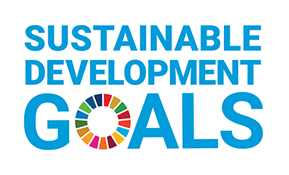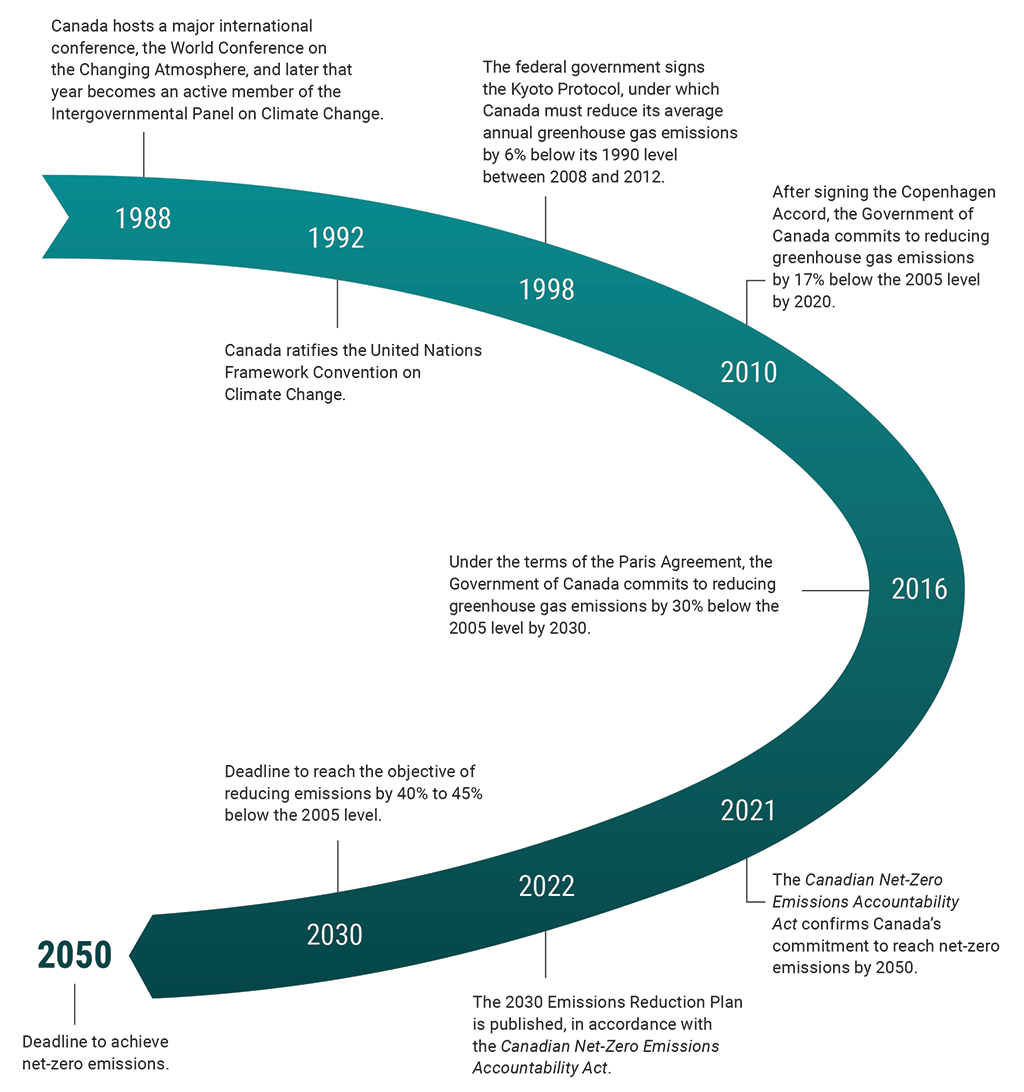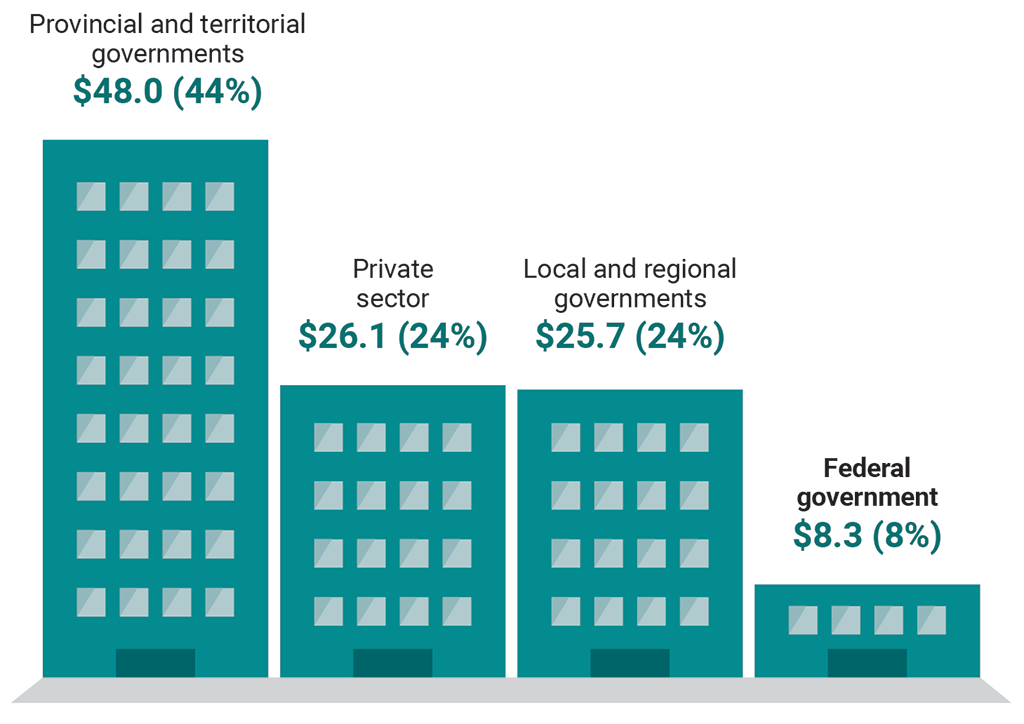2024 Reports 1 to 5 of the Commissioner of the Environment and Sustainable Development to the Parliament of Canada
Report 2—Greening of Building Materials in Public Infrastructure
At a Glance
In 2006, the federal government stated that—as one of the largest public buyers in Canada—it could show government leadership in the environmental sector by moving markets toward goods and services that carry a lower carbon footprint. In 2008, it stated that it wanted to use the infrastructure funding it provides to provinces, territories, and municipalities through transfer programs to advance its priorities, including its climate commitments.
The federal government committed to reducing greenhouse gas emissions by 40% to 45% relative to the 2005 level by 2030, but it is not on track to achieve that objective. Emissions from construction and construction materials represent 11% of Canada’s total emissions. The federal government had an opportunity to use monies allocated to public infrastructure spending—from both the infrastructure it acquires and the infrastructure it finances—to reduce the carbon footprint of construction materials.
We found that the Treasury Board of Canada Secretariat, Public Services and Procurement Canada, and Infrastructure Canada did not use their public infrastructure procurement and financing capacity effectively to prioritize the use of construction materials with a lower carbon footprint.
From 2006 to 2016, improvements in energy efficiency reduced emissions from infrastructure, but it was not until 2017 that the Treasury Board of Canada Secretariat addressed the issue of reducing the environmental impact of construction materials. Since then, progress has been made, but it is too slow given Canada’s climate goals.
For example, the secretariat established the Standard on Embodied Carbon in Construction in December 2022, but as of now, the standard applies only to ready-mix concrete. Public Services and Procurement Canada has not finished incorporating the requirements of the standard into its infrastructure procurement process. Meanwhile, Infrastructure Canada has begun—in a limited way—to integrate considerations of the embodied carbon of construction materials into its funding programs.
To increase Canada’s chances of achieving its 2030 and 2050 climate commitments, the federal government needs to speed up its work to include embodied carbon considerations in the materials used in public infrastructure construction.
Key facts and findings
- The production of construction materials accounts for 11% of global greenhouse gas emissions. Of these materials, steel and concrete are particularly harmful to the environment.
- Once a structure has been completed, it is no longer possible to significantly reduce its embodied carbon emissions. At that point, the embodied carbon of the materials in each built infrastructure is “locked in” for the life of the infrastructure.
- In 2021, governments were responsible for approximately 76% of the $108 billion spent on infrastructure, 8% of which consisted of direct federal spending. Governments have also committed to spending hundreds of billions more in the coming years.
- From 2014 to 2023, Infrastructure Canada approved more than $46 billion in federal contributions to fund infrastructure projects across the country.
- The Treasury Board of Canada Secretariat and Public Services and Procurement Canada were slow to prioritize low embodied carbon construction materials in federally owned infrastructure, focusing instead on energy efficiency.
- Infrastructure Canada has begun to integrate embodied carbon considerations into its funding programs but in a limited way.
Why we did this audit
- It is estimated that the greenhouse gas emissions from construction and construction materials account for 11% of Canada’s total emissions.
- Federal public procurement is the tool over which the Government of Canada has the most control for achieving the embodied carbon objectives of its Policy on Green Procurement.
- Insufficient consideration of embodied carbon in funding programs represents a missed opportunity to contribute to government‑wide efforts to reduce greenhouse gas emissions and achieve the 2030 climate goals.
Highlights of our recommendations
- To meet its commitments under the Greening Government Strategy and optimize the strategy’s contribution to the achievement of the 2030 climate goals, the Treasury Board of Canada Secretariat should move quickly to identify which structural construction materials, such as steel, should be included in the Standard on Embodied Carbon in Construction.
- To support government-wide efforts to speed up the reduction of greenhouse gas emissions and make progress by 2030 on Goal 9 of the United Nations’ Sustainable Development Goals and the objectives set out in the 2022–2026 Federal Sustainable Development Strategy, Infrastructure Canada should incorporate embodied carbon reduction considerations into the widest possible range of its funding programs.
Please see the full report to read our complete findings, analysis, recommendations and the audited organizations’ responses.



In 2015, Canada committed to achieving the United Nations’ 2030 Agenda for Sustainable Development. The goals include “Build resilient infrastructure, promote sustainable industrialization and foster innovation” (Goal 9) and “Take urgent action to combat climate change and its impacts” (Goal 13). The 2022–2026 Federal Sustainable Development Strategy aligns with the Sustainable Development Goals to ensure that all federal organizations are involved in implementing the United Nations’ 2030 Agenda for Sustainable Development within their areas of responsibility.
Visit our Sustainable Development page to learn more about sustainable development and the Office of the Auditor General of CanadaOAG.
Exhibit highlights
Canada’s key climate commitments

Source: United Nations and various federal government sources
Text version
This timeline shows the period from 1988 to 2050 when Canada made international commitments, enacted legislation, and set deadlines that extend to 2050.
In 1988, Canada hosts a major international conference, the World Conference on the Changing Atmosphere, and later that year becomes an active member of the Intergovernmental Panel on Climate Change.
In 1992, Canada ratifies the United Nations Framework Convention on Climate Change.
In 1998, the federal government signs the Kyoto Protocol, under which Canada must reduce its average annual greenhouse gas emissions by 6% below its 1990 level between 2008 and 2012.
In 2010, after signing the Copenhagen Accord, the Government of Canada commits to reducing greenhouse gas emissions by 17% below the 2005 level by 2020.
In 2016, under the terms of the Paris Agreement, the Government of Canada commits to reducing greenhouse gas emissions by 30% below the 2005 level by 2030.
In 2021, the Canadian Net‑Zero Emissions Accountability Act confirms Canada’s commitment to reach net-zero emissions by 2050.
In 2022, the 2030 Emissions Reduction Plan is published, in accordance with the Canadian Net‑Zero Emissions Accountability Act.
The deadline in 2030 is to reach the objective of reducing emissions by 40% to 45% below the 2005 level.
The deadline in 2050 is to achieve net‑zero emissions.
Spending on infrastructure in Canada in 2021 (billions of dollars)

Source: Based on Statistics Canada data
Text version
This exhibit compares the spending in 2021 by different levels of government and by the private sector on infrastructure in Canada. Provincial and territorial governments spent the most on infrastructure, and the federal government spent the least. The private sector and local and regional governments spent similar amounts.
Provincial and territorial governments spent $48 billion or 44% of the total spending.
The private sector spent $26.1 billion or 24% of the total spending.
Local and regional governments spent $25.7 billion or 24% of the total spending.
The federal government spent $8.3 billion or 8% of the total spending.
Evolution of Infrastructure Canada climate responsibilities
|
2008 |
Policy on Transfer Payments | Departments responsible for delivering transfer payments, including Infrastructure Canada, must design and implement programs that take the government’s priorities into account, including its climate commitments. |
|
2017 |
2016–17 Departmental Results Report | For the first time, Infrastructure Canada indicates that one of its major objectives involves reducing greenhouse gas emissions. |
|
2019 |
Minister of Infrastructure and Communities Mandate Letter | Infrastructure Canada is mandated to work with the Federation of Canadian Municipalities through the Green Municipal Fund to monitor investments and ensure they reduce emissions from residential, commercial, and multi‑unit buildings. |
|
2020 |
Federal Sustainable Development Act | In accordance with this act, Infrastructure Canada must adhere to the principles of the 2022–2026 Federal Sustainable Development Strategy. The strategy aims to “foster innovation and green infrastructure in Canada” in order to contribute by 2030 to advancing United Nations’ Sustainable Development Goal 9 (Industries, innovation and infrastructure), which is to “Build resilient infrastructure, promote sustainable industrialization and foster innovation.” |
Source: Various federal government sources
Infographic

Text version
Greening of Building Materials in Public Infrastructure
The federal government's shift to low-carbon construction materials is too slow given the urgency of the climate crisis.
Eleven percent of Canada’s total greenhouse gas emissions come from 2 sources:
- One source is the manufacturing of construction materials.
- The other source is the use of construction materials, such as concrete, steel, and aluminum, in building projects.
Greening of building materials—Federal government’s key steps to date
In 2006, the federal government introduced the Policy on Green Procurement. The Government of Canada wants to move markets toward lower carbon activities.
In 2008, the federal government introduced the Policy on Transfer Payments. The Government of Canada wants to use transfer payments to advance climate commitments.
In 2017, the federal government introduced the Greening Government Strategy. The Government of Canada wants to minimize the carbon content of construction materials.
In December 2022, the federal government established the Standard on Embodied Carbon in Construction. The standard applies only to 1 structural construction material: ready‑mix concrete. Embodied carbon refers to greenhouse gas emissions of construction materials.
The Standard on Embodied Carbon in Construction does not capitalize on the potential for reducing the carbon footprint of steel. This missed opportunity affects the federal government’s contribution to Canada's 2030 and 2050 climate goals.
In 2021, governments were responsible for 76% of the $108 billion spent on infrastructure, 8% of which consisted of direct federal spending.
Infrastructure spending in billions of dollars:
- The federal government spent $8.3 billion or 8% of the total spending.
- Local and regional governments spent $25.7 billion or 24% of the total spending.
- Provincial and territorial governments spent $48 billion or 44% of the total spending.
- The private sector spent $26.1 billion or 24% of the total spending.
Total infrastructure spending was $108.1 billion, and 76% of this spending was from the various levels of government.
To increase Canada’s chances of meeting its 2030 and 2050 climate goals, the federal government needs to accelerate its consideration and use of low-carbon construction materials in public infrastructure.
Related information
Entities
Tabling date
- 30 April 2024
Related audits
- 2022 Reports of the Commissioner of the Environment and Sustainable Development
Report 4—Funding Climate-Ready Infrastructure—Infrastructure Canada - 2023 Reports of the Commissioner of the Environment and Sustainable Development
Report 6—Canadian Net-Zero Emissions Accountability Act—2030 Emissions Reduction Plan
